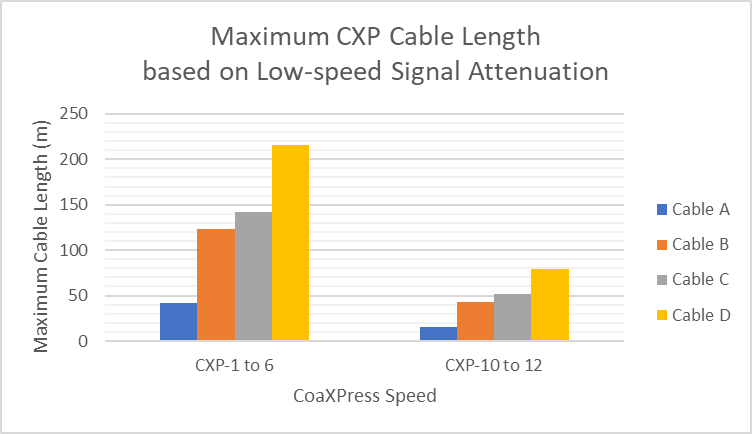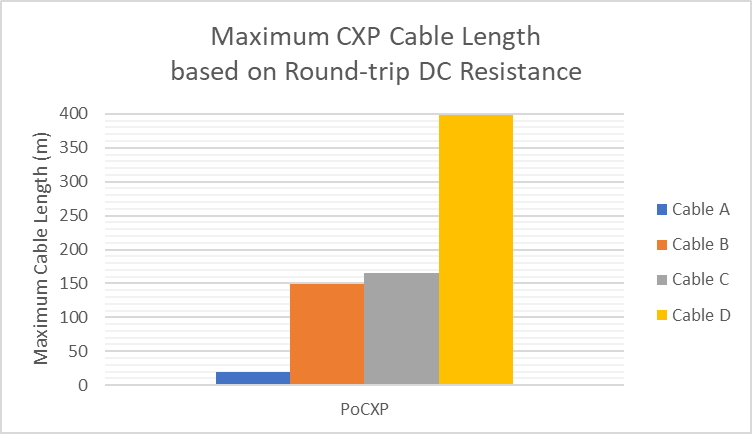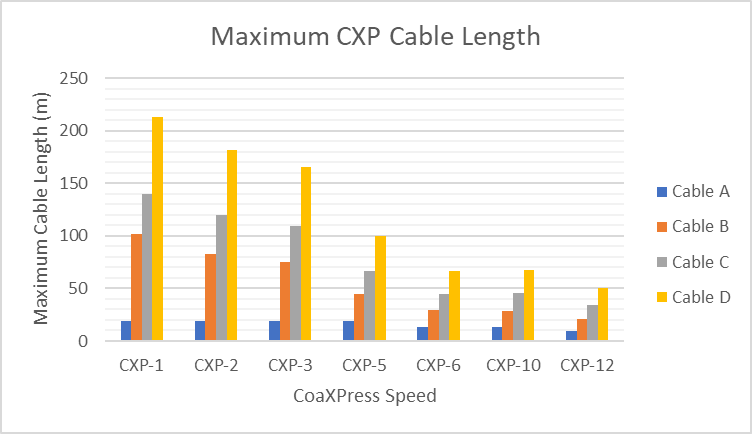Cable Length in the CoaXPress Standard
As discussed before, to calculate the maximum cable length at a given frequency, we must know the maximum attenuation allowed by the system receiver at that frequency and the corresponding signal attenuation in the cable. The CoaXPress standard not just defines the maximum signal attenuation allowed at the receiver side but also the maximum attenuation allowed for cables. The reason for that is to improve the user experience by allowing cable manufacturers to certify off-the-shelf products that can interoperate with any other CoaXPress certified product like cameras and frame grabbers. The table below shows the maximum allowed high-speed signal attenuation for receivers and cables:
|
CoaXPress |
Bit Rate |
Frequency (GHz) |
Attenuation (dB) |
Attenuation |
|---|---|---|---|---|
|
CXP-1 |
1.250 |
0.625 |
-22.0 |
-21.2 |
|
CXP-2 |
2.500 |
1.250 |
-27.2 |
-26.0 |
|
CXP-3 |
3.125 |
1.5625 |
-28.1 |
-26.8 |
|
CXP-5 |
5.000 |
2.500 |
-22.6 |
-20.9 |
|
CXP-6 |
6.250 |
3.125 |
-17.8 |
-15.8 |
|
CXP-10 |
10.000 |
5.000 |
-23.4 |
-20.8 |
|
CXP-12 |
12.500 |
6.250 |
-20.9 |
-17.9 |
The difference between the maximum attenuation for receiver and cables creates a security margin where cables must be a few meters shorter than the maximum length acceptable by the receiver. This margin guarantees that any CoaXPress certified off-the-shelf cable will interoperate with certified frame grabbers and cameras.
If we go back to the example of Cables A, B, C, and D, we obtain the following maximum lengths:

Here we can see that the answer “It depends…” is again the right one. If we take Cable C for example, it can have up to 34 m in a CXP-12 system, while in a CXP-3 system the same cable can reach up to 110 m! This shows that system parameters can also influence the maximum cable length supported.
The CoaXPress standard also defines the maximum allowed attenuation for the low-speed signals used for camera control (upstream from frame grabber to the camera). The table below shows the maximum allowed low-speed signal attenuation for receivers and cables:
|
CoaXPress |
Bit Rate |
Frequency (MHz) |
Attenuation (dB) |
Attenuation |
|---|---|---|---|---|
|
CXP-1 to 6 |
20.833 |
30 |
-4.9 |
-4.74 |
|
CXP-10 to 12 |
41.666 |
60 |
-2.6 |
-2.5 |
For example with Cables A, B, C, and D, the attenuation of low-speed signals has no impact on the maximum cable length since these parameters provide longer cables than the ones based on the high-speed attenuation parameters. As in CoaXPress both high-speed and low-speed signals are present in the same cable, the cable length will be limited by the smallest result. The graph below shows the results using the maximum allowed low-speed signal attenuation parameters:

Besides the signal attenuation along the cable, the cable length in CoaXPress can also be influenced by the round-trip DC resistance of the cable. The reason for that is the CoaXPress possibility to power the camera via the same coaxial cable used for data transfer. This feature called Power over CoaXPress (PoCXP) has a voltage drop budget of 3.5 V for a maximum current of 703 mA, which gives a maximum round-trip DC resistance of 4.98 Ω.
When we apply this parameter on Cables A, B, C, and D, we obtain the following maximum cable lengths:

These results show that the DC resistance is more important for thin cables like Cable A. Since DC resistance is the same at all CXP speeds, the maximum length for Cable A will be limited to 19 m while for Cables B, C, and D, the DC resistance have no influence.
Finally, we can obtain the following maximum cable length graph using all results from the cable attenuation for high- and low-speeds and round-trip DC resistance:

Also, regarding the CoaXPress standard, a common misunderstanding is the maximum cable length given as an example in the standard document. The CoaXPress standard uses the Belden 1694A as reference in the document to illustrate the impact of the required parameters on the cable length. Many readers take the results for the Belden 1694A as the absolute maximum cable length for CoaXPress, while, as we have seen in this article, it is just the result for one specific cable.
Off-the-shelf CoaXPress Cables
In practice, CoaXPress users don’t need to carry out the analysis of cable length as presented here. Several companies provide off-the-shelf cable assemblies respecting the CoaXPress standard requirements. Many of these companies also certify their cables by the Japan Industrial Imaging Association (JIIA) which hosts the CoaXPress standard. This certification guarantees the interoperability of all CoaXPress components (Cameras, Frame Grabbers, and Cables).
Here you can find a list of companies providing off-the-shelf CoaXPress cables:
| ● | 3M |
| ● | Alysium-Tech GmbH |
| ● | Components Express, LLC. |
| ● | HIRAKAWA HEWTECH CORP. |
| ● | NISSEI ELECTRIC CO., LTD. |
| ● | ROCKCOM |
